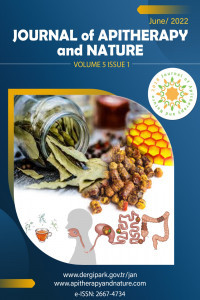Antituberculosis Activity of Propolis
Antituberculosis Activity of Propolis
Propolis, Mycobacterium tuberculosis, MIC,
___
- 1. WHO (2014). Global tuberculosis report (www.who.int/tdr/news/2014/global-TB-report/en/).World Health Organization (2010). Multidrug and extensively drug resistant TB (M/ XDR-TB) Global report on surveillance and response. Geneva: World Health
- 2 Palomino, J.C., Martin, A., Camacho, A., Guerra, H., Swings, J. ,Portaels, F.(2002). Resazurin microtiter assay plate: simple and inexpensive method for detection of drug resistance in Mycobacterium tuberculosis. Antimicrobial Agents and Chemotheraphy, 46, 2720-2722
- 3 Wayene, P.A. (2011). Susceptibility Testing of Mycobacteria, Nocarediae, and Other Aerobic Acinomycetes; Approved Standard-Second Edition. CLSI document M24-A2. USA. Clinical and Laboratory Standards Institute.
- Yayın Aralığı: Yılda 2 Sayı
- Başlangıç: 2018
- Yayıncı: Oktay YILDIZ
Chemical Profile and Botanical Origin of Stingless Bee Propolis from Thailand and Indonesia
Phenolic Compounds of Spain Propolis
Félix ADANERO-JORGE, M Camino GARCÍA-FERNÁNDEZ, Rosa M VALENCIA-BARRERA, J. Javier SANZ-GÓMEZ
Can Propolis Inhibit Infection Dynamics of Honey Bee (Apis mellifera L.) Viruses in vitro?
Muhammad IQBAL, Tai-ping FAN, David WATSON, Sameah ALENEZI, Muhamad SAHLAN
Hristo PETKOV, Boryana TRUSHEVA, Milena POPOVA, Vassya BANKOVA
Efrain ALDAY, Lucía URIBE, Dora VALENCIA, Adriana GARIBAY-ESCOBAR, Anna Lisa PICCINELLI, Luca RASTRELLI, Humberto ASTIAZARÁN-GARCÍA, Ramón Enrique ROBLES-ZEPEDA, Javier HERNANDEZ, Carlos VELAZQUEZ
Erzsébet-timea DOMOKOS, Adriana URCAN, Liviu Alexandru MARGITAS, Daniel Severus DEZMIREAN, Otilia BOBIS
İsamara Julia CAMURI, Adriano Batista COSTA, Wallance Moreira PAZIN, Amando Siuiti ITO
Isolated Triterpenes from Stingless Bee Lisotrigona furva Propolis in Vietnam
Le Nguyen THANH, Vu Thi Kim OANH, Ha Thi THOA, Diep Thi Lan PHUONG, Nguyen Thi Phuong LIEN, Tran Huu GIAP, Nguyen Thi Minh HANG, Nguyen Van HUNG, Vassya BANKOVA
In Vitro Evaluation of Green and Red Propolis Extracts Against Candida spp
M. D. FREITAS, G. A. LOPES, N. A OLIVEIRA, B. M. ALMEIDA, S. R. L. ABREU, R. C. BASQUES, N. S. BINDA, S. M. FIGUEIREDO
